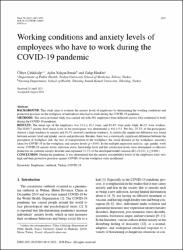| dc.contributor.author | Çelikkalp, Ülfiye | |
| dc.contributor.author | Irmak, Aylin Yalçın | |
| dc.contributor.author | Ekuklu, G. | |
| dc.date.accessioned | 2022-05-11T14:02:59Z | |
| dc.date.available | 2022-05-11T14:02:59Z | |
| dc.date.issued | 2021 | |
| dc.identifier.issn | 1051-9815 | |
| dc.identifier.uri | https://doi.org/10.3233/WOR-210643 | |
| dc.identifier.uri | https://hdl.handle.net/20.500.11776/4563 | |
| dc.description.abstract | This study aims to evaluate the anxiety levels of employees by determining the working conditions and protective practices in the workplace of individuals who had to work during the COVID-19 pandemic. METHODS: The cross-sectional study was carried out with 801 employees from different sectors who continued to work during the COVID-19 pandemic. RESULTS: The mean age of the employees was 33.1±10.3 years, and 63.4%were male while 46.1%were workers. The GAD-7 anxiety level mean score of the participants was determined as 6.6±5.1. Per this, 25.2%of the participants showed a high tendency to anxiety and 38.5%showed a moderate tendency. A statistically significant difference was found between anxiety level and gender, sector and profession. Besides, there was a statistically significant difference between the perception of workplace risk, the way of transportation to the workplace, the social distance in the workplace, measures taken for COVID-19 in the workplace, and anxiety levels (p<0.05). In the multiple regression analysis, age, gender, work sector, COVID-19 anxiety levels, infection status, knowledge level and life satisfaction levels were determined as effective predictors on common anxiety disorder and explained 23.2%of the developed model variance (R2=0.232, p?0.001). CONCLUSION: During the pandemic, it was determined that the anxiety susceptibility levels of the employees were very high and their protective practices against COVID-19 in the workplace were insufficient. © 2021 - IOS Press. All rights reserved. | en_US |
| dc.language.iso | eng | en_US |
| dc.publisher | IOS Press BV | en_US |
| dc.identifier.doi | 10.3233/WOR-210643 | |
| dc.rights | info:eu-repo/semantics/openAccess | en_US |
| dc.subject | COVID-19 | en_US |
| dc.subject | Employees | en_US |
| dc.subject | outbreak | en_US |
| dc.subject | Turkey | en_US |
| dc.subject | adult | en_US |
| dc.subject | anxiety | en_US |
| dc.subject | cross-sectional study | en_US |
| dc.subject | epidemiology | en_US |
| dc.subject | health care personnel | en_US |
| dc.subject | human | en_US |
| dc.subject | male | en_US |
| dc.subject | pandemic | en_US |
| dc.subject | young adult | en_US |
| dc.subject | Adult | en_US |
| dc.subject | Anxiety | en_US |
| dc.subject | COVID-19 | en_US |
| dc.subject | Cross-Sectional Studies | en_US |
| dc.subject | Health Personnel | en_US |
| dc.subject | Humans | en_US |
| dc.subject | Male | en_US |
| dc.subject | Pandemics | en_US |
| dc.subject | SARS-CoV-2 | en_US |
| dc.subject | Young Adult | en_US |
| dc.title | Working conditions and anxiety levels of employees who have to work during the COVID-19 pandemic | en_US |
| dc.type | article | en_US |
| dc.relation.ispartof | Work | en_US |
| dc.department | Fakülteler, Tıp Fakültesi, Dahili Tıp Bilimleri Bölümü, Halk Sağlığı Ana Bilim Dalı | en_US |
| dc.department | Yüksekokullar, Sağlık Yüksekokulu, Hemşirelik Bölümü | en_US |
| dc.identifier.volume | 70 | en_US |
| dc.identifier.issue | 4 | en_US |
| dc.identifier.startpage | 1047 | en_US |
| dc.identifier.endpage | 1055 | en_US |
| dc.institutionauthor | Çelikkalp, Ülfiye | |
| dc.institutionauthor | Irmak, Aylin Yalçın | |
| dc.relation.publicationcategory | Makale - Uluslararası Hakemli Dergi - Kurum Öğretim Elemanı | en_US |
| dc.authorscopusid | 56247310100 | |
| dc.authorscopusid | 56708761400 | |
| dc.authorscopusid | 6603449796 | |
| dc.identifier.wos | WOS:000734505400006 | en_US |
| dc.identifier.scopus | 2-s2.0-85122128456 | en_US |
| dc.identifier.pmid | 34842219 | en_US |



















